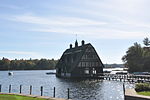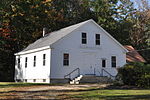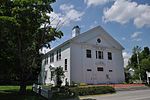Cold River (Bearcamp River tributary)
New Hampshire river stubsRivers of Carroll County, New HampshireRivers of New Hampshire
The Cold River is an 11.9-mile-long (19.2 km) river in the White Mountains of New Hampshire in the United States. It is a tributary of the Bearcamp River, part of the Ossipee River and Saco River watersheds. The river lies entirely in the town of Sandwich. The Cold River begins on the southern slopes of Sandwich Mountain, within the Sandwich Wilderness of the White Mountain National Forest. The river flows generally east and then southeast, leaving the national forest, passing New Hampshire Route 113A in the village of Whiteface, and reaching the Bearcamp River close to the Sandwich/Tamworth town line.
Excerpt from the Wikipedia article Cold River (Bearcamp River tributary) (License: CC BY-SA 3.0, Authors).Cold River (Bearcamp River tributary)
State Route 25,
Geographical coordinates (GPS) Address Nearby Places Show on map
Geographical coordinates (GPS)
| Latitude | Longitude |
|---|---|
| N 43.828333333333 ° | E -71.341666666667 ° |
Address
State Route 25
State Route 25
03883
New Hampshire, United States
Open on Google Maps









